Diabetes Tech in the Ozempic Era
Helping Patients Navigate Ulcerative Colitis and Crohn’s Disease
 Shakeel Ahmed, M.D. CEO, Atlas Surgical Group
Shakeel Ahmed, M.D. CEO, Atlas Surgical Group







Diabetes Tech in the Ozempic Era
Helping Patients Navigate Ulcerative Colitis and Crohn’s Disease
 Shakeel Ahmed, M.D. CEO, Atlas Surgical Group
Shakeel Ahmed, M.D. CEO, Atlas Surgical Group






There are two simple ways to request information about the products and services found in Physicians Office Resource.
1. Go to www.PhysiciansOfficeResource.com and enter the four-digit reference number found next to the product or service into the search field, then request additional information, schedule a demo, or speak with a sales agent all with just a simple click of a button.
2. Find the Business Reply Card in this issue, circle the desired reference numbers, complete the form, and drop into any USPS mailbox. A representative will contact you as quickly as possible to answer your questions. www.PhysiciansOfficeResource.com
PUBLISHED BY Medical Education Resources, LLC
PUBLISHER
Aaron R. Medaris amedaris@physiciansofficeresource.com
CEO
Andrew C. Nimmo acnimmo@physiciansofficeresource.com
PRESIDENT
John D. Pasquale jpasquale@pharmaconnect.com
BUSINESS MANAGER
Marci J. Hills mhills@physiciansofficeresource.com
TRAVEL EDITOR
Brandi L. Brower
EDITORIAL BOARD
Michael Paquin, FHIMSS Barry Craig, MLT (NCA), CLC
STAFF WRITER
Dylan J. Chadwick
CREATIVE DIRECTOR PRODUCTION MANAGER
Jessica Elmer
Copyright ©2024
To continue your free subscription of Physicians Office Resource magazine, please fill out the Business Reply Card (BRC) located within this magazine and drop in any United States Post Office mailbox.
If you are a manufacturer of medical products or provide services to medical professionals and would like to advertise your products or services to the nation’s top physicians doing in-office testing, call 801-380-6094 or visit: POR.io for more information.

The Metrix® COVID-19 is a novel technology includes clinical claims for symptomatic and asymptomatic individuals, along with dual-sample types for nasal or saliva, allowing for an enhanced point-of-care testing experience. The reader is compact and robust, it’s ideal for professional use in diverse locations, including clinics and mobile health units. It’s a maintenance free device with no calibration step required. View Brochures, Videos & More at POR.io Enter Number 3713 in the Search Area
How to Create a Medical Empire
Part 1: The Blueprint to Financial Riches in Healthcare
Diabetes Tech in the Ozemic Era
I doubt anyone would argue that we have seen major advancements in diabetes technology.
Helping Patients Navigate Ulcerative Colitis and Crohn's Disease
It’s estimated that an approximate 3 million adults in the United States have been diagnosed with inflammatory bowel disease (IBD).

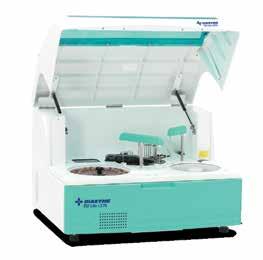
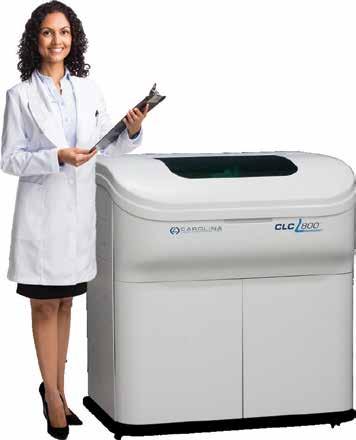

PART 1 OF A SIX PART SERIES
“Do not wait to strike till the iron is hot; but make it hot by striking.”
– William Butler Yeats
This is the first of a 6-article series I will write on how to invest in healthcare, and strike gold in the business of medicine. This collection of writings will serve as a repository of guidance and schematics for those venturing into the realm of healthcare entrepreneurship. It aims to distill and expand upon the different healthcare investment opportunities accessible to both newcomers and experienced investors alike, detailing the necessary actions to ensure the success of these investments. Furthermore, the series will explore the myriad legal and regulatory challenges encountered in the medical industry, paying particular attention to the intricacies associated with various healthcare organizations and the strategies for entering these specific sectors.
While designed to be accessible to both the general public and healthcare investors, the emphasis will predominantly be on aiding physician investors in navigating their way to economic prosperity within the healthcare domain.
“The only place where success comes before work is in the dictionary.” – Vidal Sassoon
Over the past two decades, my journey has encompassed the acquisition and establishment of over a dozen medical franchises, including several ambulatory surgery centers and medical practices. This experience has afforded me a unique insight into the seemingly intricate world of healthcare investment, revealing its underlying simplicity. Consider healthcare entrepreneurship as a life puzzle that is awaiting your solution. Through these articles, I aim to guide the
reader in unlocking this conundrum, offering a perspective through my own experiences in this arena.
The initial step towards embarking on the lucrative path of medical ventures is to seek inspiration from the industry’s pioneers. It’s about more than just replicating their actions; it’s about understanding and adopting their mindset. Within the vast landscape of medicine, examining all prosperous ventures and industries to discern what contributes to their success is crucial. Observing the strategies of these industry leaders can provide invaluable insights for achieving financial dominance in your endeavors. The genetic makeup of a successful healthcare entrepreneur is not distinct from your own; their success is achieved through a blend of vision, perseverance, diligence, and thorough research. Hence, it’s evident that navigating the road to healthcare prosperity or to the foundation of a multimillion-dollar enterprise is fraught with challenges, necessitating a synergy of several factors—vision, unwavering effort, persistence, and yes, a dose of research.
“I have not failed. I’ve just found 10,000 ways that won’t work.”
– Thomas A. EdisonWhile attributing success to luck might appear to be an oversimplification, it’s important to recognize that without dedication and perseverance, relying solely on luck is as effective as banking on a lottery win. Luck alone is insufficient; however, a steadfast commitment to hard work and resolve significantly amplifies your prospects of attaining these ambitious financial objectives. By adhering to specific steps and strategies, one can markedly enhance the likelihood of realizing these goals.
So, what are some steps one can take in this journey towards financial nirvana. Let’s explore some key concepts:
Initiating the journey towards sustained achievement in healthcare ventures begins with establishing a clear and precise objective. This involves defining concrete, quantifiable, and attainable goals for both yourself and your enterprise. It’s crucial to possess a vivid vision of your desired outcomes and the strategies for realizing them. The essence of success lies in the feasibility of your goals and the thoroughness of your planning. A strategy that predisposes you to failure is far from effective.
Forging ahead to build a thriving business necessitates cultivating a robust sense of ethic. Embodying a strong work ethic signifies undertaking whatever is necessary for success, even when it’s neither enjoyable nor easy. At times, the effort required can be thoroughly unappealing. Indeed, enduring lengthy hours is undesirable; making sacrifices is hard; and incessantly challenging yourself is tough. Ventures yielding substantial income demand significant dedication and hard work. Nonetheless, you persevere because the fragrance of triumph never blossoms without enduring some unpleasantness.
“The difference between ordinary and extraordinary is that
little extra.” – Jimmy Johnson
The transition from foul to fragrant is gradual and often imperceptible during the journey. Therefore, sustaining a steadfast work ethic is imperative—consistently. It’s critical to understand that achieving business success isn’t a singular event; it represents an ongoing endeavor. It calls for relentless dedication, concentration, patience, and tenacity. Possessing a work ethic that’s sporadic or only predominant most of the time does not constitute a genuine work ethic.
Cultivating creativity is another vital step. The ranks of millionaires and billionaires are frequently populated by individuals who challenge conventional thinking to forge novel and distinctive concepts. Lateral thinking encourages a departure from logical and secure thought processes. Embrace this manner of thinking. Just as dreams in sleep bypass logic and safety, your conscious aspirations should be no different. Your frontal lobes are there to process and organize the outcomes of such thought. Lateral thinking might lead you to create a new product or service, uncover a new market, or devise a novel solution to a problem. Success involves risks and misses, but without venturing a try, successes remain elusive. Venturing these attempts is the exhilarating part.
Networking stands as a crucial pillar in achieving these goals. Establishing robust connections and fostering relationships within your industry can unlock new prospects and offer invaluable insights and support. Like a spider in its web, a successful individual can identify where the strands of networking intersect, perceiving patterns among even the most distant contacts. The potential is as vast as the cosmos!
Investing represents a critical stride towards prosperity. Diversifying your investments in healthcare-related assets, such as stocks, real estate, and various businesses, can facilitate wealth accumulation over time. It’s essential to conduct thorough research and make informed investment decisions, but equally important is the readiness to embrace calculated risks. This is where the analytical meets the intuitive side of your brain.
Maintaining financial discipline and wisely managing your resources is crucial. This involves living within your financial capabilities, saving diligently, and steering clear of unnecessary debts. It also encompasses making prudent financial decisions and channeling your funds into promising investments.
A pivotal strategy for financial growth is to diversify your income sources. Depending on a single income stream is akin to a one-trick pony that may falter. Avoid the vulnerability of a solitary income source that could vanish, leaving you in a precarious position. Cultivating multiple income avenues renders you resilient against financial calamities; there’s no larger fiscal peril than being dependent on a singular, failing source. Note
that obligations persist even when income sources falter. Should your primary income source collapse, recovering from financial losses could take years. Creating additional income streams acts as a safeguard against misfortune, whether it’s unforeseen or inevitable. Initiating a sideline business, investing in property, or generating passive income are ways to enhance your financial security. Like your main occupation, vigilance for opportunities is key, along with maintaining an innovative mindset. Embrace your unique ability to foster additional revenue streams. Consider this practical example: If you provide car repair services, imagine securing a contract to maintain the local police department’s fleet at a discounted rate. Such visibility could attract customers who value your association with the police force, distinguishing you from competitors often marred by mistrust, with no concessions offered to these newly attracted clients.
Embracing new opportunities is essential for financial success. Engage in lateral thinking and utilize both analytical and creative skills, as business triumph requires a blend of logical problem-solving and creativity. Often, the most lucrative opportunities emerge from the least expected places. Welcoming novel ideas and being willing to take calculated risks can open doors to unforeseen financial gains. Failure of a risk should be seen as a minor setback, a challenge to navigate as you remain focused on your goals. For instance, observing a neighborhood with poorly maintained streets might reveal a demand for a house leveling service, an area you might be unfamiliar with but holds potential due to the lack of competition equipped for such tasks. Or, noticing a shortage of luggage carts at your local airport could present an opportunity to propose a solution to the
airport administration, despite your lack of experience in engineering or navigating airport logistics. These examples serve to illustrate the importance of staying alert to possibilities.
Lastly, achieving success in healthcare entrepreneurship transcends financial gain. It’s about the positive impact you have on lives and leveraging your wealth to contribute meaningfully to society. Essentially, it’s about valuing what truly matters in life. Rarely does anyone reflect on their life wishing for material acquisitions. More often, they cherish the relationships and experiences shared with others, intertwining their financial journey with deeper human connections.
Equipped with this solid base of principles, you’re thoroughly prepared to dive into the medical business world and achieve success. In the following chapter, we’ll delve deeper into the various business opportunities available for the budding entrepreneur.
Dr. Shakeel Ahmed is a digestive and liver disease specialist practicing in Fairview Heights IL. He completed 3 years of fellowship training in Gastroenterology and Hepatology at the University of Louisville. Dr. Ahmed is board certified by the American Board of Gastroenterology/ Hepatology, which confirms the highest qualification and knowledge in the field of gastroenterology. Dr. Ahmed’s practice further specializes in advanced therapeutic endoscopy, which includes complicated pancreatobiliary disorders and their management. Centre for Gastrointestinal Health is one of the largest referral centers for ERCP’s and EUS and all pancreatobiliary disorders in the Greater Saint Louis area.

Dr. Shakeel Ahmed is the founder and CEO of Atlas Surgical Group, the largest privately owned group of ambulatory surgery centers in the Midwest. He started his foray into outpatient surgery in Illinois, and over the course of two decades has been instrumental in the design and development, construction, and the running and management of dozens of surgical facilities. His key to success in building a franchise of this type comes not just from his thorough knowledge of the administrative process involved, but also from his intimate involvement as a gastroenterologist who actively performs thousands of procedures at his facilities, thus giving him firsthand exposure to negotiate and manage this highly complex field. Having performed hundreds of thousands of surgeries over the past few decades, Atlas Surgical Group specializes in all different areas of medicine, with special focus on orthopedic surgery, spinal surgery, ophthalmology, gynecology, plastic surgery, podiatry, gastroenterology, pain management, and bariatric surgery.

from Newman Medical
Your Patients Trust YOU To Find Their Peripheral Artery Disease
• High-risk patients include those over 65, diabetics, and smokers.
• If left untreated, 25% of patients with PAD will experience a heart attack or stroke within 5 years.
• PAD symptoms are often mistaken for arthritis or old age.
• The simpleABI Cuff-Link System is Easy to Learn and Use.
• With a push-button remote, automatic calculations, and waveforms, it’s incredibly user-friendly.
• Reports are straightforward to save and share since the system is PC-based.
Outstanding Value and Reimbursements
• The system pays for itself in less than a year with just one test per week.
• Medicare reimbursements vary by exam and location, averaging from $91 to $174.
View Brochures, Videos & More at POR.io
Enter Number 3804 in the Search Area
From Bindex Medical
Comparable to DXA
Extensive clinical research has proven Bindex to be 90% accurate in detecting osteoporosis. It can replace nearly 70% of DXA scans for patients with suspected osteoporosis. Fast and effective
Using safe pulse-echo ultrasound to measure cortical bone thickness, Bindex analyzes bone density in just seconds. Easy to use anywhere
Lightweight and pocket-sized, Bindex allows patients to receive onthe-spot bone density scans in doctors’ offices, hospitals and clinics and at home.
View Brochures, Videos & More at POR.io
Enter Number 3805 in the Search Area
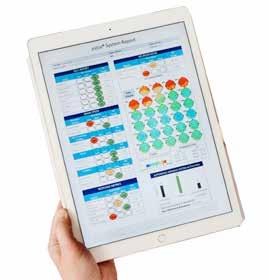
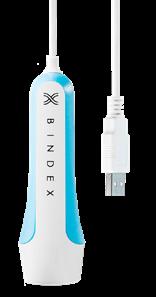
From Evoke Neuroscience
The eVox® System is an FDA 510(k) cleared medical device to aid primary and specialty care physicians in diagnosis of memory loss and other cognitive disorders. eVox® measures memory loss biomarkers that may aid in detecting memory loss sooner, identifying the root cause of memory loss, and performing a differential diagnosis. eVox® procedures are performed in-office and are reimbursable by Medicare and commercial payers.
View Brochures, Videos & More at POR.io
Enter Number 3806 in the Search Area

(PAD) is an often silent condition where narrowed arteries reduce blood flow to the legs, causing symptoms like leg pain, numbness, and slow-healing wounds.
Diabetics
Smokers
Over age 65
DON’T LET PAD SNEAK UP ON YOU OR THESE PATIENTS.
50% report no symptoms, while those that do attribute their pain to arthritis or “old age”.
EASY
No Doppler or vascular anatomy knowledge necessary. Can be done in five minutes or less by any staff member. Non-invasive, patient-friendly test.
ACCURATE
Accuracy equal or better than Doppler ABI. Useful for diabetics with calcified arteries.
REIMBURSABLE

THESE PATIENTS TRUST YOU TO FIND THEIR PAD
before they have a heart attack, stroke, or even die. PAD also leads to significant disability and reduced quality of life
Great ROI: the typical internist has 800 Medicare patients, per ACP. Testing five patients per week can pay for the system in less than two months. CPT 93923, with a national average of $142/exam.
With over 40 years of experience in diagnostic ultrasound, Newman Medical is a trusted leader in vascular testing solutions Newman's ABI-Q rapid-test system epitomizes their commitment to pioneering technology. Built on integrity and expertise, count on Newman Medical for precise, rapid, and reliable vascular testing solutions to learn how early PAD detection benefits both your patients and your practice
a free live demo
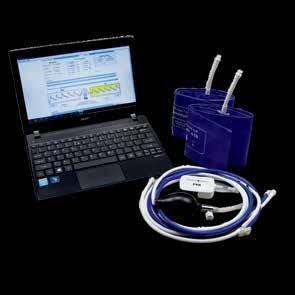


















VOWST—the FIRST and ONLY orally administered microbiome therapeutic to prevent C. diff * recurrence1,2






PERCENTAGE OF PARTICIPANTS WITHOUT C. DIFF RECURRENCE AT 24 WEEKS1,3‡§
VOWST FOLLOWING ANTIBIOTICS (n=89)


P<0.001

(n=93)

§Relative risk of 0.46 (95% CI, 0.30, 0.73).






• The majority of adverse reactions were mild or moderate in severity1




• Most adverse reactions occurred within 10 days of starting VOWST1
– The median duration of these events was ≤5 days1




• No serious adverse events were considered related to the use of VOWST1








VOWST is indicated to prevent the recurrence of Clostridioides difficile infection (CDI) in individuals 18 years of age and older following antibacterial treatment for recurrent CDI (rCDI).
Limitation of Use: VOWST is not indicated for treatment of CDI.


Please see accompanying Brief Summary of Prescribing Information on the following page, and www.VOWSThcp.com for full Prescribing Information. Discover more at VOWSThcp.com





BRIEF SUMMARY OF PRESCRIBING INFORMATION
This Brief Summary does not include all the information needed to use VOWST® safely and effectively.
See Full Prescribing Information for VOWST. VOWST (fecal microbiota spores, live–brpk) capsules, for oral administration
Initial U.S. Approval: 04/2023
VOWST is indicated to prevent the recurrence of Clostridioides difficile infection (CDI) in individuals 18 years of age and older following antibacterial treatment for recurrent CDI (rCDI). Limitations of Use: VOWST is not indicated for treatment of CDI.
WARNINGS AND PRECAUTIONS
Transmissible infectious agents. Because VOWST is manufactured from human fecal matter, it may carry a risk of transmitting infectious agents. Any infection suspected by a healthcare provider possibly to have been transmitted by this product should be reported by the healthcare provider to Aimmune Therapeutics, Inc., at 1-833-246-2566.
Potential presence of food allergens. VOWST is manufactured from human fecal matter and may contain food allergens. The potential for VOWST to cause adverse reactions due to food allergens is unknown.
The safety of VOWST was evaluated in one Phase 3, randomized, double-blind clinical study (Study 1) and in one Phase 3, open-label clinical study (Study 2). The majority of participants were White (92.3%) and female (68.9% in Study 1; 68.4% in Study 2). In Study 1, 5.2% of participants were Black. Across the two studies, the median age of VOWST recipients was 66 years (range 21-100 years). Rates of comorbidities were similar across studies.
The most common adverse reactions in Study 1 [reported in ≥5% of Vowst-treated participants, and at a rate greater than placebo) were abdominal distension (31.1%), fatigue (22.2%), constipation (14.4%), chills (11.1%), and diarrhea (10.0%).
The most commonly reported adverse reactions in Study 2 were gastrointestinal in nature (flatulence (4.2%), diarrhea (3.4%), and nausea (3.0%)], and all were unsolicited. Across both studies, most adverse reactions were mild to moderate in severity. Among 349 VOWST recipients, there were no serious adverse events considered related to VOWST.
VOWST contains bacterial spores; therefore, antibacterials should not be administered concurrently with VOWST.
Pregnancy. There are no data on use of VOWST in pregnant women. Developmental toxicity studies in animals have not been conducted with VOWST.
Lactation. It is not known whether VOWST is excreted in human milk. Data are not available to assess the effects of VOWST on breastfed infants or on milk production/excretion.
Pediatric Use. The safety and effectiveness of VOWST in individuals under 18 years of age have not been established.
Geriatric Use. Data from clinical studies are not sufficient to determine if adults 65 years of age and older respond to VOWST differently from younger adults.
VOWST has not been evaluated for carcinogenicity, genotoxicity, mutagenic potential, or impairment of male or female fertility in animals.
Distributed by:
Aimmune Therapeutics, Inc.
1007 US Highway 202/206, Building JR2, Suite E102 Bridgewater, NJ 08807
Manufactured by:
Seres Therapeutics, Inc.
200 Sidney St., Cambridge, MA 02139
US License Number: 2262
VOWST is a trademark of Seres Therapeutics, Inc. Unless otherwise indicated, all trademarks are owned by Société des Produits Nestlé S.A., Vevey, Switzerland or used with permission.
© 2024 Nestlé.
VOW-PM-USA-0159 01/24
From
A fully-automated, open system, benchtop clinical chemistry analyzer with throughput up to 270 tests/hour, 36 reagent positions, and 30 sample positions. It features a menu of over 60 CLIA moderate complexity assays, including cancer markers, cardiovascular markers, coagulation markers, diabetic markers, inflammatory markers, liver markers, renal/pancreatic markers, sepsis markers, vitamin markers, photometric electrolytes, and drugs of abuse. To learn more, visit https://www.carolinachemistries.com/products/dz-lite-c270-benchtop-chemistry-analyzer/.
View Brochures, Videos & More at POR.io
Enter Number 3808 in the Search Area
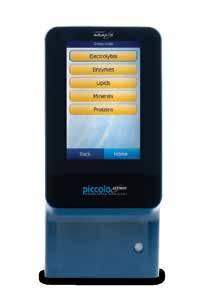
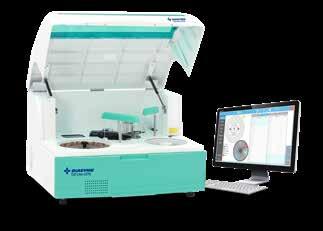
FULL COMPLEMENT OF CLIA-WAIVED BLOOD CHEMISTRY TESTS PICCOLO XPRESS® CHEMISTRY ANALYZER
Full Complement of CLIA-waived Blood Chemistry Tests Piccolo Xpress® Chemistry Analyzer from Abbott
From Abbott Point of Care
The Piccolo Xpress Chemistry Analyzer provides physician offices with lab-accurate results for a broad range of CLIA-waived general chemistry tests, including metabolic panels, lipids, liver, and kidney function, and more with just 100 microliters of blood. Easy to use, the Piccolo Xpress provides results during a patient’s visit, accelerating treatment decisions, increasing efficiency, and supporting patient satisfaction. Automated quality control on every test helps ensure accuracy.
The Piccolo Xpress Chemistry Analyzer provides physician offices with lab-accurate results for a broad range of CLIAwaived general chemistry tests, including metabolic panels, lipids, live, and kidney function, and more with just 100 microliters of blood. Easy to use, the PIccolo Xpress provides results during a patient’s visit, accelerating treatment decisions, increasing efficiency, and supporting patient satisfaction. Automated quality control on every test helps ensure accuracy.
For in vitro diagnostic use only. This material is intended for a U.S. audience only.
Piccolo Xpress is a registered trademark of Abaxis, Inc. and distributed by Abbott Point of Care
View Brochures, Videos & More at POR.io
Physician Office Resource Piccolo Product Description – US 3065.REV1 08/20
Enter Number 3809 in the Search Area
When starting a lab, look no further. With a CLIA moderately complex menu of 35 general chemistries and 14 urine drug screens, the EasyRA is well-suited for oncology, rheumatology, and multi-specialty practices needing a benchtop clinical chemistry analyzer. The EasyRA offers photometric throughput of 240+ tests/hr (up to 480 tests/hr with ISE) and STAT samples in under 8 minutes. This all-in-one system is easy to learn and easy to operate.
View Brochures, Videos & More at POR.io
Enter Number 3810 in the Search Area
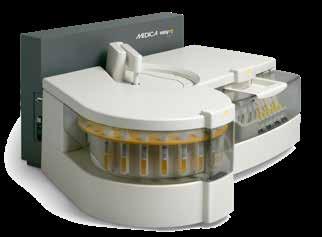
3811
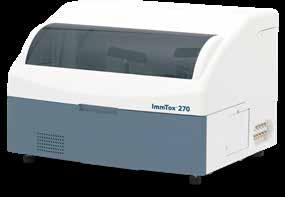
TOXICOLOGY SCREENING SIMPLIFIED ABBOTT’S IMMTOX 270 BENCHTOP ANALYZER NOW WITH 14 ASSAYS CLIA CATEGORIZED AS MODERATE COMPLEXITY
From Abbott
The ImmTox270 benchtop analyzer offers comprehensive toxicology screening solutions for physician offices, treatment centers and independent laboratories.
Broad test menu with over 20 assays to choose from including 14 that are now available as moderately complex.
With complete laboratory solutions from consultation to licensure, and compliance the Abbott Clinical Laboratory Solutions team has you covered.
View Brochures, Videos & More at POR.io
Enter Number 3811 in the Search Area 3812
FIRST EVER FDA-CLEARED AND CATEGORIZED, POINT-OF-CARE FENTANYL TEST (<6 MINUTES)
From Carolina Liquid Chemistries
Carolina Liquid Chemistries Corp. introduces the Fentanyl Urine Detection Test on CLC’s next-generation RYAN™ immunofluorescent analyzer. This FDA cleared and CLIA categorized, moderately complex, compact, point-of-care system detects fentanyl qualitatively in human urine at a cutoff concentration of 1.0 ng/mL. The test can be run in < 6 minutes, produces a chartable result, and is interfaceable. For detailed information, visit carolinachemistries.com/products/fentanyl-urinedetect-on-clc-ryan-analyzer/.
View Brochures, Videos & More at POR.io
Enter Number 3812 in the Search Area

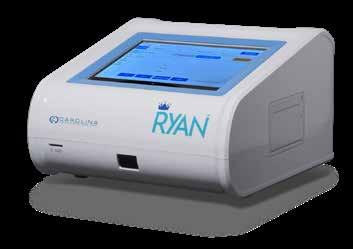
DC-LINEATE CALIBRATION/ LINEARITY MATERIAL
From SEKISUI Diagnostics
The DC-Lineate is a unique, trilevel calibration/linearity material that is used in conjunction with assays for the quantitative determination of UIBC levels in clinical samples. The material is conveniently packaged in a 2 x 5 mL configuration for each of the three levels and is traceable back to the National Institute of Standards and Technology (NIST). It can be used on a broad range of clinical chemistry analyzers and has a shelf life up to 14-days after reconstitution.
View Brochures, Videos & More at POR.io
Enter Number 3813 in the Search Area


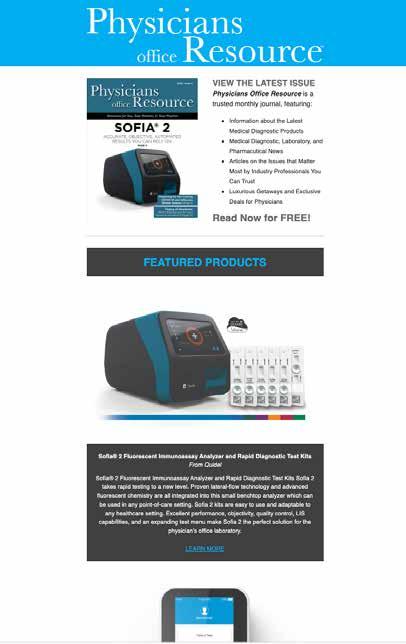

I doubt anyone would argue that we have seen major advancements in diabetes technology. Conventional fingerstick glucose monitors (BGM) while still around are being replaced by Continuous Glucose Monitoring Systems (CGM). Insulin pumps have become Automated Insulin Delivery systems using CGM and sophisticated insulin dosing algorithms which learn. Insulin pens once “dumb” devices have transformed into “smart” connected devices.
There are a plethora of apps which do everything from tracking activity to helping patients more effectively manage their diabetes. It’s not an understatement to say our mobile phones have become a valuable healthcare tool. Throw in all the websites which help patients and social media sites where patients can help each other and it’s easy to see why technology has changed diabetes management and healthcare in general forever.
However, thanks to drugs like Ozempic, Wegovy, Mounjaro and Rybelsus, some believe there is no future for all this whiz bang way cool technology, that their future is bleak. Publicly traded companies such as Dexcom and Insulet have seen their shares prices plumet as analysts falsely believe that these new therapies will dominate diabetes/obesity management.
It’s easy to understand why they feel this way as these therapy options are very effective, simple to use and in high demand. Therapy adherence is not an issue with these latest drugs. Patients want to use them and are willing to pay $1,000 a month or more to do so. Understandably, shares of Novo Nordisk and Eli Lilly have taken off like a rocket due to the high demand for these therapies.
Yet the perception that they will kill the future for diabetes technology is just that, a perception. Here’s why:
· To date, none of these therapies are approved for people with Type 1 diabetes.
· While extraordinarily popular they are NOT for every patient.
· As effective as they are, physicians are loath to change a treatment paradigm which is working.
· Given their cost and how they work, patients regain weight if they stop taking them. Yes, reimbursement is improving but it’s still not widespread.
· Recent evidence suggests that CGM sales are being enhanced by these therapies as patients once they lose the weight use CGM technology to help them keep the weight off.
Let’s examine the Type 1 market first. As you know patients with Type 1 diabetes must have insulin. Even with the advanced AID systems only 35% of Type I patients use this technology. Old fashioned syringes remain the cheapest and
most popular insulin delivery option. Insulin pens, even the connected version, are the second most popular option.
Put simply given the size of the market, which unfortunately continues to grow, these systems have plenty of room to grow. Patients already using this technology will NOT abandon it because of these new therapies. These technologies also have another advantage as they are widely reimbursed and therefore cheaper than the newer therapies.
The wildcard is the larger Type 2 market. Intensive insulin management has grown in popularity but these patients who either don’t produce enough insulin or don’t absorb insulin well or both are candidates for the newer drugs. The unknown questions are how many will either convert to the new drugs and how many will be out on them and not even get to using insulin.
In the near term my belief is while some Type 2 patients will adopt the newer drugs as whole, they will not hurt usage of diabetes technology. As we mentioned earlier, the newer options are not cheap and if they are already doing well using diabetes technology, why switch?
Insulet is the perfect case study here. The Omnipod system is very popular not just with Type 1 patients but also patients with Type 2 diabetes who previously followed multiple daily injection (MDI) therapy. The Omnipod is discreet, easy to use, widely reimbursed, available via the pharmacy channel while producing solid patient outcomes. Is it possible that sales of the Omnipod will be impacted in the future? Of course, but we are talking about years not months in the future.
Dexcom is the perfect case study for CGM. Besides being a critical component of the newer AID systems and widely adopted by patients following MDI therapy, CGM is also becoming a general health and wellness tool. Abbott the makers of the Libre CGM recently noted that sales of Libre have been positively impacted by the newer therapies for the reason I stated earlier.
It should be noted that Novo Nordisk and Lilly have connected insulin pen options which communicate with Dexcom’s and Abbott’s CGM systems. These are the companies that are dominating the GLP-1 market. They know full well that not every patient will adopt GLP-1 therapy. Simply put, insulin usage will not fall into the abyss because of their other drugs.
Suffice it to say, in the near-term diabetes technology is alive and doing very well. The long-term impact in the Type 2 market remains unclear but it would NOT prevent me from recommending companies like Dexcom and Insulet as investment options. Change as we know happens slowly in diabetes/obesity management. There is no question whatsoever these new drugs are game changing. Their impact cannot be understated. But to paraphrase Mark Twain, reports of diabetes technology death have been greatly exaggerated.
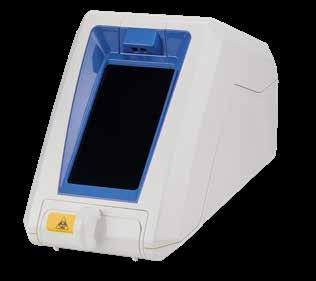
From Sekisui Diagnostics
The Acucy™ Influenza A&B Test is for the rapid, qualitative detection of influenza A and B viral nucleoprotein antigens from both nasal and nasopharyngeal swabs. Utilizing the Acucy™ Reader in either the point-of-care or laboratory setting, workflow flexibility is achieved with both Read Now and Walk Away features. The combination provides clinicians with standardized and definitive result interpretation.
View Brochures, Videos & More at POR.io
Enter Number 3814 in the Search Area
From bioMerieux
bioMérieux knows that an evolving world deserves evolved diagnostics. Our latest innovation, the BIOFIRE® SPOTFIRE® Respiratory Solution, is the first FDA-cleared and CLIA-waived COVID-19 testing solution. The BIOFIRE® SPOTFIRE® System is an easy-to-use system that runs the BIOFIRE® SPOTFIRE® Respiratory (R) Panel. Benefits of the SPOTFIRE Respiratory Solution include: 15 respiratory targets on 1 PCR test with results in about 15 minutes; minimal benchtop space with vertical scalability up to four modules; easy to use with an intuitive user interface.
View Brochures, Videos & More at POR.io
Enter Number 3815 in the Search Area


From Sekisui Diagnostics
The OSOM® BVBLUE® detects elevated vaginal fluid sialidase activity, an enzyme produced by bacterial pathogens associated with bacterial vaginosis including Gardnerella, Bacteroides, Prevotella and Mobiluncus. OSOM® BVBLUE® is more sensitive than Amsel criteria providing physicians with a more accurate diagnosis to treat and minimize serious health consequences such as early spontaneous preterm births and miscarriage.
View Brochures, Videos & More at POR.io
Enter Number 3816 in the Search Area
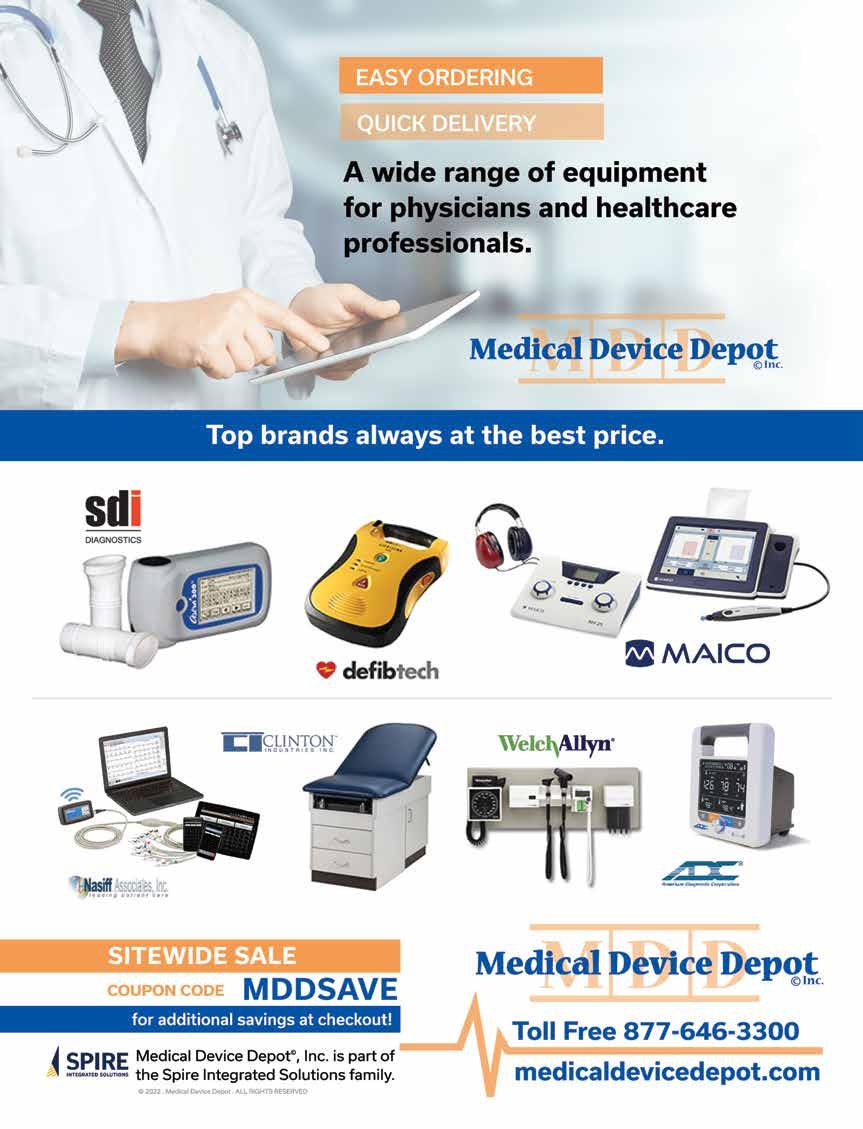
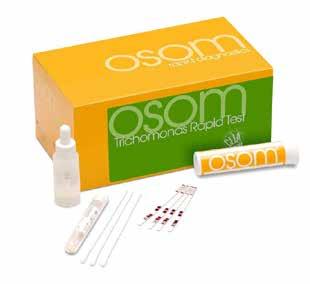
From Sekisui Diagnostics
The OSOM® Trichomonas Rapid Test is intended for the qualitative detection of Trichomonas vaginalis antigens from vaginal swabs or from the saline solution. The OSOM® Trichomonas Rapid Test is a CLIA-waived rapid test available today. OSOM® Trichomonas is more sensitive than wet mount due to the assay being able to detect viable and non-viable organisms which offers significant benefits to the patient and clinician alike.
View Brochures, Videos & More at POR.io
Enter Number 3825 in the Search Area
From Sekisui Diagnostics
Stronger Clinical Performance Takes Lateral Flow Testing To The Next Level. Providing superior rapid results at the point-of-care. Fast, easy, cost effective so you can test and treat in one visit.
• High Performance- Equivalent or exceeding the performance of reader devices, without the need for an instrument
• Results in 10 minutes
• OSOM® Custom Care- Exceptional Support/Training by licensed medical technologists and experienced healthcare professionals
• Made in the USA
View Brochures, Videos & More at POR.io
Enter Number 3826 in the Search Area
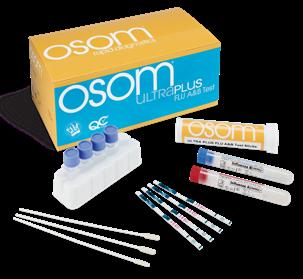
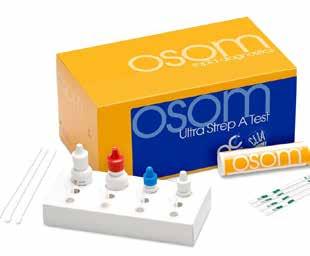
From Sekisui Diagnostics
The OSOM® Ultra Strep A test is a color immunochromatographic assay intended for the qualitative detection of Group A Streptococcus antigen directly from throat swab specimens. Shown to be not statistically different than single swab culture. Sensitivity 95.7% and 100% Specificity. Includes two additional test sticks for External QC. CLIA Waived..
View Brochures, Videos & More at POR.io
Enter Number 3827 in the Search Area
Comprehensive toxicology menu now with 14 CLIA 1 categorized moderate complexity assays.


Toxicology screening solutions for physician offices, pain management, treatment centers and laboratories testing 200+ patient samples/mo.
MODERATE COMPLEXITY ASSAYS – FDA 510(K) CLEARED
6-acetylmorphine (6-AM Heroin metabolite)
Amphetamine
Barbiturates
Benzodiazepines
Benzoylecgonine (Cocaine metabolite)
Buprenorphine
Cannabinoids (THC)

EDDP (Methadone metabolite)
Fentanyl*
Methamphetamine
Opiates
Oxycodone
Phencyclidine (PCP)
Tramadol
Scan this QR code to view the ImmTox™ 270 product video

WHY COMPROMISE? FAST AND RELIABLE RESULTS ARE NOW DELIVERED AT THE POINT OF CARE.
From LumiraDx
Introducing the next generation in point-of-care diagnostics. With a growing menu of tests, LumiraDx uses a simple process that allows for more time with your patients by using microfluidic technology that delivers results in minutes. Learn more about rapid COVID-19 diagnostic solutions for your physician office at LumiraDx.com.
View Brochures, Videos & More at POR.io
Enter Number 3829 in the Search Area
SOFIA® 2 FLUORESCENT IMMUNOASSAY ANALYZER AND RAPID DIAGNOSTIC TEST KITS
From Quidel
Sofia® 2 Fluorescent Immunoassay Analyzer and Rapid Diagnostic Test Kits Sofia 2 takes rapid testing to a new level.
Proven lateral-flow technology and advanced fluorescent chemistry are all integrated into this small benchtop analyzer which can be used in any point-of-care setting. Sofia 2 kits are easy to use and adaptable to any healthcare setting. Excellent performance, objectivity, quality control, LIS capabilities, and an expanding test menu make Sofia 2 the perfect solution for the physician’s office laboratory.
View Brochures, Videos & More at POR.io
Enter Number 3830 in the Search Area


BE PREPARED FOR RESPIRATORY SEASONS WITH THE OSOM® COVID-19 ANTIGEN RAPID TEST
From Sekisui
OSOM® COVID-19 Antigen Rapid Test has not been FDA cleared or approved. It is authorized by FDA under an EUA for prescription use only. It has been authorized only for the detection of SARS-CoV-2 antigen, not for any other viruses or pathogens and is only authorized for the duration of the declaration that circumstances exist justifying the authorization of emergency use of in vitro diagnostics for detection and/or diagnosis of COVID-19 under Section 564(b)(1) of the Federal Food, Drug, and Cosmetic Act, 21 U.S.C S360bbb-3(b)(1), unless the authorization is terminated or revoked sooner. 3831
The OSOM® COVID-19 Antigen Rapid Test is a lateral flow immunoassay that detects the SARS-CoV-2 nucleocapsid protein with a nasal swab in only 15 minutes at the point-of-care. The test is intended to be used by healthcare professionals or operators on patients suspected of COVID-19 within the first 7 days of symptom onset. The clinical performance compares favorably against polymerase chain reaction methodology, with a positive percent agreement of 95.1% and a negative percent agreement of 97%.
View Brochures, Videos & More at POR.io
Enter Number 3831 in the Search Area


 3832
3832
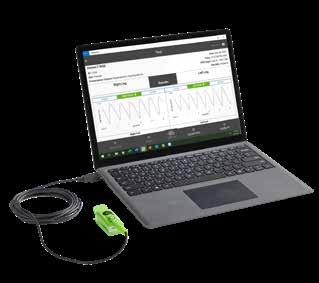
From Semler Scientific
QuantaFlo® PAD is an easy to use, accurate, point of care, non-invasive solution that aids in the early detection of peripheral arterial disease (PAD). This FDA cleared device can be administered by a medical aide in less than 5 minutes. As published in the Journal of Vascular Surgery and the American Journal of Preventive Medicine, QuantaFlo detected undiagnosed PAD in 31.6% of patients +65.1 QuantaFlo is portable and integrates with other technologies and platforms. It is ideal for both home and clinic environments.
1. Smolderen KG, Ameli O, Chaisson CE, Heath K, Mena-Hurtado C. Peripheral Artery Disease Screening in the Community and 1-Year Mortality, Cardiovascular Events, and Adverse Limb Events, AJPM Focus (2022), https://doi.org/10.1016/j.focus.2022.100016
View Brochures, Videos & More at POR.io
Enter Number 3833 in the Search Area
From Nova Biomedical
The U.S. FDA has cleared Nova Primary as a blood glucose reference analyzer that fills the need for a new reference analyzer to replace the YSI STAT PLUS 2300 (YSI, Inc., Yellow Springs, OH). Manufacturers of blood glucose measuring devices and clinical diabetes researchers have relied on the YSI 2300 as a reference and correlation analyzer. However, YSI, Inc. no longer supports the analyzer, and its discontinuation has left a critical industry void. With today’s FDA clearance, Nova Primary from Nova Biomedical is now available in the U.S. and worldwide.
View Brochures, Videos & More at POR.io
Enter Number 3834 in the Search Area
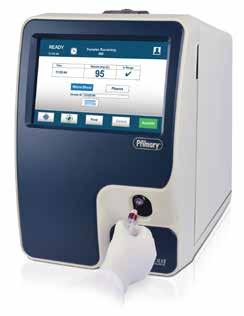

EARLY DETECTION AND MANAGEMENT OF CHRONIC CONDITIONS WITH DCA VANTAGE® AND CLINITEK STATUS®+ ANALYZERS
From Siemens Healthineers
Siemens Healthineers DCA Vantage® and CLINITEK Status® family of analyzers provide Hemoglobin A1c (HbA1c) and albumin-to-creatinine ratio (ACR) testing at the point of care. Monitor glycemic control in patients with diabetes and screening for kidney disease in patients atrisk, in-office. Enable real-time consultation, eliminating loss to followup. Improve the patient experience and overall outcome by providing actionable results in minutes.
CLIA-waived: DCA HbA1c; CLINITEK Microalbumin 2 (ACR)
CLIA Moderate Complexity: DCA® Microalbumin/Creatinine (ACR)
View Brochures, Videos & More at POR.io
Enter Number 3835 in the Search Area
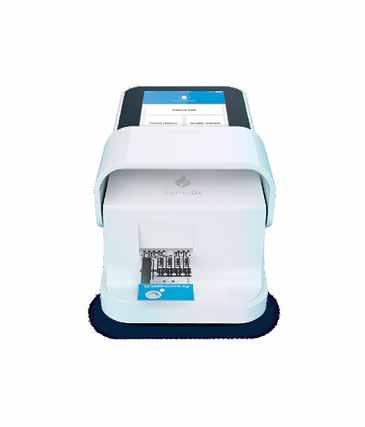

3837
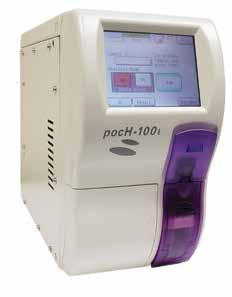
From Abbott
With reduced budgets, shrinking laboratory space and staffing challenges, many laboratories need a solution that lets them work smarter with less. The CELL-DYN Emerald 22 AL is a full performance, automated optical 5-part differential analyzer that delivers smarter results for small to midsize clinical laboratories.
• Compact Design
• Walkaway Functionality
• Ease Of Use
• Smart Safety Features
View Brochures, Videos & More at POR.io
Enter Number 3838 in the Search Area
From Sysmex
Designed for labs testing up to 25 samples per day, the Sysmex pocH-100i™ has the smallest footprint of any analyzer on the market. The instrument requires only 15uL of whole blood for reporting of 17 clinical parameters, including a 3-part WBC Differential. It is ideal for urgent care, physician office lab, small clinic, or any outpatient setting where a point of care CBC is needed.
View Brochures, Videos & More at POR.io
Enter Number 3837 in the Search Area

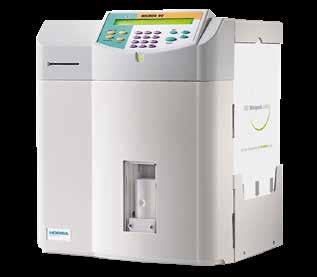
MICROS HEMATOLOGY ANALYZER WITH 3-PART DIFFERENTIAL PLUS THE LITEDM
From HORIBA Medical
Is it viral or bacterial? A CBC with 3-part differential can provide the clues to help distinguish between viral and bacterial infections before you decide to treat. The Micros 60 Hematology analyzer provides a CBC with 3-part Diff result in less than 60 seconds using only 10 µL of sample. Connect to the LiteDM Patient Data Management System for an affordable way to consolidate patient results to one report.
View Brochures, Videos & More at POR.io
Enter Number 3839 in the Search Area
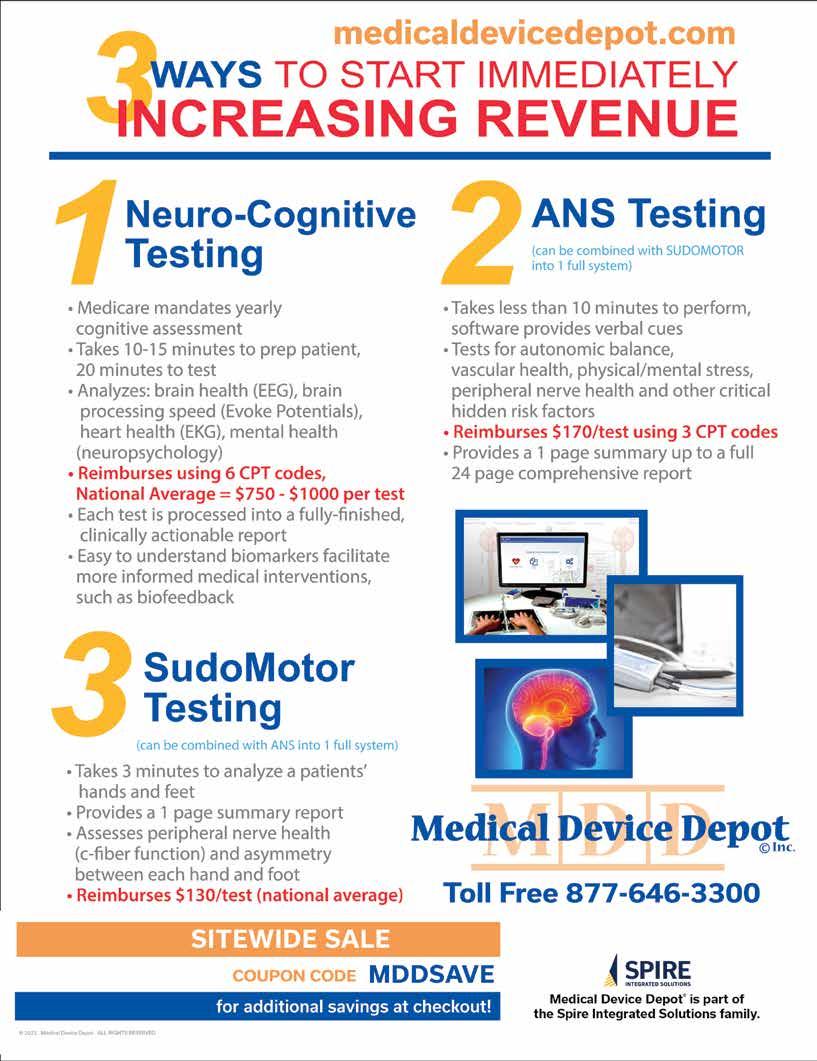
 3840
3841
3842
3840
3841
3842

It’s estimated that an approximate 3 million adults in the United States have been diagnosed with inflammatory bowel disease (IBD). Of those 3 million, the most common forms of IBD include Ulcerative Colitis (UC) and Crohn’s Disease. In this article we’ll take a closer look at the similarities, differences, treatments and what you can do as a primary care physician to help your patients navigate their battle with these diseases.
Similarities Between Ulcerative Colitis and Crohn’s Disease
Ulcerative colitis (UC) and Crohn’s disease are both chronic inflammatory bowel diseases (IBD) that significantly impact the gastrointestinal tract. While they have distinct characteristics, there exist notable similarities between these conditions, highlighting shared pathophysiological mechanisms and clinical features. Recognizing these parallels is essential for accurate diagnosis, effective management, and improved patient outcomes.
Inflammatory Nature:
Both UC and Crohn’s disease involve chronic inflammation of the gastrointestinal tract, although the patterns and locations of inflammation differ. In UC, inflammation typically affects the colon and rectum, while Crohn’s disease can involve any part of the digestive tract, from the mouth to the anus.
Autoimmune Component:
Both conditions are believed to result from an abnormal immune response, where the immune system mistakenly attacks the body’s own tissues in the gastrointestinal tract. This autoimmune component contributes to the chronic inflammation seen in both diseases.
Symptomatology:
UC and Crohn’s disease share common gastrointestinal symptoms, including abdominal pain, diarrhea (often bloody in UC), rectal bleeding, urgency to have bowel movements, and fatigue. Additionally, both conditions can present with extraintestinal manifestations, such as joint pain, skin rashes, eye inflammation, and liver problems.
Periods of Remission and Flare-Ups:
Both UC and Crohn’s disease have a relapsing-remitting course characterized by periods of remission, during which symptoms improve or disappear entirely, followed by flare-ups, where symptoms worsen or new symptoms develop. The timing and duration of these periods vary among individuals and may require adjustments to treatment strategies.
Increased Risk of Complications:
Both conditions can lead to various complications, such as strictures (narrowing of the intestine), fistulas (abnormal connections between parts of the intestine or between the intestine and other organs), abscesses, and an increased risk of colon cancer (in UC) or small bowel cancer (in Crohn’s disease).
Diagnostic Challenges:
Diagnosing UC and Crohn’s disease often involves a combination of medical history, physical examination, blood tests, imaging studies (such as endoscopy, colonoscopy, or CT scans), and sometimes biopsy of the affected tissue. Due to the similarities in symptoms and presentation, distinguishing between the two conditions can sometimes be challenging and may require multiple tests.
Treatment Approaches:
While there is no cure for either UC or Crohn’s disease, the treatment goals are similar: to control inflammation, relieve symptoms, and maintain remission. Treatment options may include medications (such as anti-inflammatory drugs, immunosuppressants, biologics), dietary modifications, lifestyle changes, and in some cases, surgery to remove damaged portions of the intestine.
Differences Between Ulcerative Colitis and Crohn’s Disease
Ulcerative colitis and Crohn’s disease are both inflammatory bowel diseases (IBD), but they have some key differences in terms of symptoms, location, and patterns of inflammation:
Location of Inflammation:
Ulcerative colitis typically affects the innermost lining of the colon (large intestine) and rectum. The inflammation usually starts in the rectum and then spreads continuously to involve other parts of the colon.
Crohn’s disease can affect any part of the digestive tract from the mouth to the anus, although it most commonly affects the end of the small intestine (ileum) and the beginning of the colon. The inflammation can occur in patches and can involve the entire thickness of the bowel wall.
Symptoms:
Symptoms of ulcerative colitis often include bloody diarrhea, abdominal pain, and urgency to have bowel movements. Crohn’s disease symptoms may include abdominal pain and cramping, diarrhea (which may or may not be bloody), fatigue, weight loss, and sometimes complications such as fistulas (abnormal connections between parts of the intestine) or strictures (narrowing of the intestine).
Pattern of Inflammation:
In ulcerative colitis, inflammation is continuous and usually starts in the rectum and moves upward to involve other parts of the colon in a contiguous manner.
In Crohn’s disease, inflammation can occur in patches with normal areas of bowel in between. It can also affect the entire thickness of the bowel wall.
Complications:
Ulcerative colitis can lead to complications such as severe bleeding, perforation of the colon, and an increased risk of colon cancer.
Crohn’s disease can lead to complications such as strictures (narrowing of the intestine), fistulas (abnormal connections between parts of the intestine or between the intestine and other organs), abscesses, and malabsorption of nutrients.
Extraintestinal Manifestations:
Both diseases can have extraintestinal manifestations, which means symptoms outside of the digestive tract. These may include joint pain, skin rashes, eye inflammation, and liver problems.
Diagnostic Differences:
Diagnosis of ulcerative colitis and Crohn’s disease typically involves a combination of medical history, physical examination, blood tests, imaging studies (such as endoscopy, colonoscopy, or CT scans), and sometimes biopsy of the affected tissue.
There are several treatment options available for ulcerative colitis and Crohn’s Disease, and the choice of treatment depends on the severity of the disease, the extent of inflammation, the presence of complications, and individual patient factors. Treatment aims to reduce inflammation, relieve symptoms, induce and maintain remission, and improve the quality of life for individuals. Here are some common treatment approaches:
Medications:
· Aminosalicylates (UC only): Drugs such as mesalamine, sulfasalazine, and balsalazide are used to reduce inflammation in the colon and help control mild to moderate symptoms.
· Corticosteroids (UC only): Short-term use of corticosteroids such as prednisone or budesonide may be necessary to control moderate to severe symptoms during flare-ups.
· Immunomodulators (UC and Crohn’s): Drugs such as azathioprine, 6-mercaptopurine, and methotrexate are used to suppress the immune system and reduc inflammation. They are often used for maintenance therapy to prevent flare-ups.
· Biologic therapies (UC and Crohn’s): These medications target specific proteins involved in the inflammatory response. Biologics such as infliximab, adalimumab, golimumab, vedolizumab, and ustekinumab are commonly used for moderate to severe ulcerative colitis that does not respond to other treatments.
Nutritional Therapy:
· Enteral nutrition: This involves consuming liquid formulas or specially formulated diets to provide nutrition while resting the bowel. Enteral nutrition may be used as a primary therapy in children or as adjunctive therapy in adults with Crohn’s disease.
· Exclusive enteral nutrition (EEN): EEN involves consuming only liquid formulas for a period of time, usually several weeks, to induce remission in active ulcerative colitis.
Surgery:
· Ulcerative Colitis: Surgery may be necessary for severe ulcerative colitis that does not respond to medical therapy or for complications such as severe bleeding,
perforation of the colon, or increased risk of colon cancer. Surgery may involve removal of the entire colon and rectum (proctocolectomy) with creation of an ileal pouch-anal anastomosis (IPAA or J-pouch) or creation of an ileostomy.
· Crohn’s Disease: Surgery may be necessary for complications of Crohn’s disease, such as strictures (narrowing of the intestine), fistulas (abnormal connections between parts of the intestine or between the intestine and other organs), abscesses, or bowel obstruction. Surgery may involve removing the affected portion of the intestine (resection) or repairing fistulas.
· Dietary modifications: While there’s no specific diet that works for everyone with UC and/or Crohn’s, some individuals find relief from symptoms by avoiding certain foods that trigger flare-ups, such as dairy, high-fiber foods, or spicy foods. Keeping a food diary can help identify trigger foods.
· Smoking cessation: Smoking is a known risk factor for UC and Crohn’s and can worsen symptoms. Quitting smoking may help improve symptoms and reduce the risk of complications.
Supportive Therapies:
· Pain management (UC and Crohn’s): Over-the-counter or prescription pain medications may be used to manage abdominal pain and discomfort.
· Counseling and support: Living with UC or Crohn’s Disease can be challenging, so counseling, support groups, and mental health resources can be beneficial for coping with the emotional and psychological impact of the disease.
Primary care physicians play a crucial role in the care and management of patients with inflammatory bowel disease (IBD), such as ulcerative colitis and Crohn’s disease. While gastroenterologists typically take the lead in managing the specific aspects of IBD, primary care physicians can provide valuable support and coordination of care, particularly in areas such as preventive health, monitoring for complications, and addressing comorbidities. Here are several ways in which primary care physicians can help patients with IBD:
Diagnosis and Referral:
Primary care physicians are often the first point of contact for patients with gastrointestinal symptoms. Recognizing the signs and symptoms suggestive of IBD and promptly referring patients to gastroenterologists for further evaluation and diagnosis is essential for timely management.
Education and Counseling:
Providing patients with information about their condition,
treatment options, and lifestyle modifications is crucial. Primary care physicians can educate patients about the chronic nature of IBD, the importance of medication adherence, dietary considerations, and strategies for managing symptoms and stress.
Monitoring Disease Activity:
While gastroenterologists typically monitor disease activity and treatment response in patients with IBD, primary care physicians can play a role in monitoring for signs of disease exacerbation or complications during routine follow-up visits. This may involve assessing symptoms, monitoring inflammatory markers, and coordinating care with gastroenterologists as needed.
Managing Medications:
Primary care physicians can assist in managing medications commonly used in IBD, such as aminosalicylates, corticosteroids, immunomodulators, and biologic therapies. This may involve prescribing medications for comorbid conditions, monitoring for medication side effects, and ensuring appropriate vaccinations, including influenza and pneumococcal vaccines.
Preventive Health Care:
Primary care physicians can address preventive health care needs in patients with IBD, including routine screenings for colorectal cancer, osteoporosis, and other potential complications associated with chronic inflammation or long-term medication use. They can also provide guidance on smoking cessation, maintaining a healthy weight, and managing other modifiable risk factors.
Coordination of Care:
Facilitating communication and collaboration between specialists, such as gastroenterologists, nutritionists, mental health professionals, and surgeons, is essential for providing comprehensive care to patients with IBD. Primary care physicians can serve as a central point of contact for coordinating referrals, sharing medical information, and ensuring continuity of care.
Support and Advocacy:
Offering emotional support and advocacy for patients with IBD can have a significant impact on their overall well-being. Primary care physicians can lend a compassionate ear, validate patients’ concerns, and connect them with resources such as support groups, counseling services, and patient advocacy organizations.
By actively engaging in the care of patients with IBD, primary care physicians can help optimize outcomes, enhance quality of life, and provide comprehensive support to individuals living with these chronic inflammatory conditions. Collaboration between primary care providers and gastroenterologists is essential for delivering holistic, patient-centered care to those affected by IBD.

From bioMerieux
bioMérieux knows that an evolving world deserves evolved diagnostics. Our latest innovation, the BIOFIRE® SPOTFIRE® Respiratory Solution, is the first FDA-cleared and CLIA-waived COVID-19 testing solution. The BIOFIRE® SPOTFIRE® System is an easy-to-use system that runs the BIOFIRE® SPOTFIRE® Respiratory (R) Panel. Benefits of the SPOTFIRE Respiratory Solution include: 15 respiratory targets on 1 PCR test with results in about 15 minutes; minimal benchtop space with vertical scalability up to four modules; easy to use with an intuitive user interface.
View Brochures, Videos & More at POR.io
Enter Number 3843 in the Search Area
From Sekisui Diagnostics
The Acucy™ Influenza A&B Test is for the rapid, qualitative detection of influenza A and B viral nucleoprotein antigens from both nasal and nasopharyngeal swabs. Utilizing the Acucy™ Reader in either the point-of-care or laboratory setting, workflow flexibility is achieved with both Read Now and Walk Away features. The combination provides clinicians with standardized and definitive result interpretation.
View Brochures, Videos & More at POR.io
Enter Number 3844 in the Search Area


From Sekisui Diagnostics
Stronger Clinical Performance Takes Lateral Flow Testing To The Next Level. Providing superior rapid results at the point-of-care. Fast, easy, cost effective so you can test and treat in one visit.
• High Performance- Equivalent or exceeding the performance of reader devices, without the need for an instrument
• Results in 10 minutes
• OSOM® Custom Care- Exceptional Support/Training by licensed medical technologists and experienced healthcare professionals
• Made in the USA
View Brochures, Videos & More at POR.io
Enter Number 3845 in the Search Area
From Semler Scientific
QuantaFlo® PAD is an easy to use, accurate, point of care, non-invasive solution that aids in the early detection of peripheral arterial disease (PAD). This FDA cleared device can be administered by a medical aide in less than 5 minutes. As published in the Journal of Vascular Surgery and the American Journal of Preventive Medicine, QuantaFlo detected undiagnosed PAD in 31.6% of patients +65.1 QuantaFlo is portable and integrates with other technologies and platforms. It is ideal for both home and clinic environments.
1. Smolderen KG, Ameli O, Chaisson CE, Heath K, Mena-Hurtado C. Peripheral Artery Disease Screening in the Community and 1-Year Mortality, Cardiovascular Events, and Adverse Limb Events, AJPM Focus (2022), https://doi.org/10.1016/j.focus.2022.100016
View Brochures, Videos & More at POR.io
Enter Number 3846 in the Search Area


from Newman Medical
Your Patients Trust YOU To Find Their Peripheral Artery Disease
• High-risk patients include those over 65, diabetics, and smokers.
• If left untreated, 25% of patients with PAD will experience a heart attack or stroke within 5 years.
• PAD symptoms are often mistaken for arthritis or old age.
The simpleABI Cuff-Link System is Easy to Learn and Use.
• With a push-button remote, automatic calculations, and waveforms, it’s incredibly user-friendly.
• Reports are straightforward to save and share since the system is PC-based.
Outstanding Value and Reimbursements
• The system pays for itself in less than a year with just one test per week.
• Medicare reimbursements vary by exam and location, averaging from $91 to $174.
View Brochures, Videos & More at POR.io
Enter Number 3847 in the Search Area
From bioMérieux
The BIOFIRE® FILMARRAY® TORCH is a fully integrated, random, and continuous-access system designed to meet your laboratory’s syndromic infectious disease testing needs. The benchtop footprint of the BIOFIRE TORCH saves precious lab space, and its scalability meets high throughput demands. BIOFIRE® FILMARRAY® Link Software automatically uploads patient results. Fully compatible with all BIOFIRE® FILMARRAY® Panels intended for use in CLIA-moderate settings, the BIOFIRE TORCH helps you maximize efficiency and productivity.
View Brochures, Videos & More at POR.io
Enter Number 3848 in the Search Area


From Sekisui Diagnostics
The OSOM® BVBLUE® detects elevated vaginal fluid sialidase activity, an enzyme produced by bacterial pathogens associated with bacterial vaginosis including Gardnerella, Bacteroides, Prevotella and Mobiluncus. OSOM® BVBLUE® is more sensitive than Amsel criteria providing physicians with a more accurate diagnosis to treat and minimize serious health consequences such as early spontaneous preterm births and miscarriage.
View Brochures, Videos & More at POR.io
Enter Number 3849 in the Search Area
From Sekisui Diagnostics
The OSOM® Trichomonas Rapid Test is intended for the qualitative detection of Trichomonas vaginalis antigens from vaginal swabs or from the saline solution. The OSOM® Trichomonas Rapid Test is a CLIA-waived rapid test available today. OSOM® Trichomonas is more sensitive than wet mount due to the assay being able to detect viable and non-viable organisms which offers significant benefits to the patient and clinician alike.
View Brochures, Videos & More at POR.io
Enter Number 3850 in the Search Area

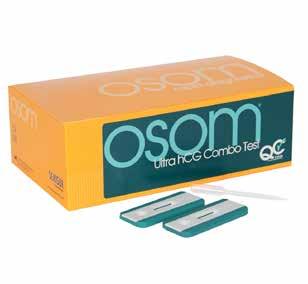
From Sekisui Diagnostics
The OSOM® Ultra hCG Combo test is a simple immunoassay for the qualitative detection of human chorionic gonadotropin (hCG) in serum or urine for the early confirmation of pregnancy. Internal studies have confirmed that the OSOM® Ultra hCG Combo test does not have a false negative result from hCG variants providing physicians with a higher level of confidence.
View Brochures, Videos & More at POR.io
Enter Number 3851 in the Search Area





MDescapes features exclusive luxury travel discounts and offers! Our goal is to reward you, the healthcare professional, and help provide the rest, adventure, and memoires that accompany a luxury vacation.


